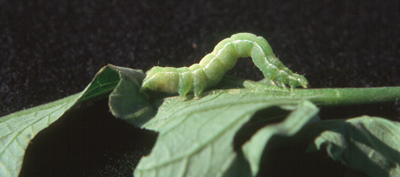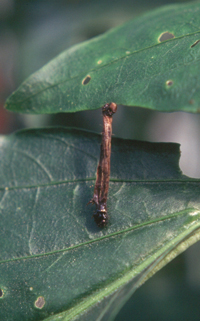
Features
Biocontrols
Inputs
Greenhouse Growers Notes: Cabbage looper control with Btk
June 17, 2009 By Gillian Ferguson
Cabbage loopers infest greenhouse vegetable crops every year, either
from annual migration of adult moths from the south or from populations
that have carried over from the previous year.
Cabbage loopers infest greenhouse vegetable crops every year, either from annual migration of adult moths from the south or from populations that have carried over from the previous year.
The major strategy for managing looper populations in greenhouse vegetables is the use of the biological control agent, Bacillus thuringiensis subsp. kurstaki, also referred to as Btk, which is marketed as Dipel®, Foray®, and Bioprotec®.
 |
|
| Healthy cabbage looper feeding on a tomato leaf. photo courtesy Gillian Ferguson, OMAFRA
|
Btk is a bacterium that uniquely forms protein crystals when producing spores, and it is the protein crystals that are the toxic component of Btk. After a looper ingests the spores and crystals of Btk that have been applied to the foliage, the crystals dissolve in the alkaline medium of the stomach. Within 24 to 48 hours, the dissolved crystals cause the stomach wall to break down and the spores begin to invade the body. The looper then dies from the combined effects of starvation and tissue damage, resulting in a happy grower.
However, there are some mitigating factors that could result in less than perfect control when using Btk against loopers.
 |
|
| Cabbage looper corpse killed after ingesting leaves with the biological control agent Bacillus turingiensis subsp. kurstaki. photo courtesy Gillian Ferguson, OMAFRA |
Possibility of resistant pest populations
One such factor could be the presence of resistant populations that have either migrated from outdoor populations, or that have overwintered in the greenhouse. Work done at the University of British Columbia (UBC) by Alida Janmaat and Judith Myers between 2000 and 2002 in greenhouse vegetable crops, revealed the existence of cabbage looper populations that were resistant to Btk.
In those greenhouses where the most resistant populations were found, growers had reported poor control using Btk. Also, the total amount of Btk applied bore a strong relationship to the level of resistance measured. Fortunately, however, lab studies by the UBC researchers also found that this resistance was unstable. They found that resistance generally declined in the absence of Btk exposure, so that rotation with another product having a different mode of action was associated with a decrease in resistance. This study reinforces the need to reduce reliance on a single strategy. It also emphasizes the need for a thorough cleanup at the end of the season to ensure there’s no carryover of resistant populations from one season to the next.
interval between applications can also reduce effectiveness
Another factor that must be considered in the effectiveness of Btk is the interval between applications, because the toxicity of Btk declines with time as a result of the effects of the environment. Field studies done in the late 1970s at the California Polytechnic State University concluded that it is the combined action of sunlight, leaf temperature and vapour pressure deficit that
contributes to decay of Btk.
Under greenhouse conditions, however, there is some protection afforded by the greenhouse cover. The amount of light protection from the cover would depend on the wavelength that is transmitted. The California study indicated that light wavelengths greater than or equal to 400 nm have the greatest killing action on Btk spores. Work done in B.C. greenhouse vegetable operations by the same UBC workers mentioned above, indicated that the toxicity of Btk at five days after application was similar or slightly reduced, when compared with toxicity at one day after application. Toxicity had declined to 50 per cent at nine days after application.
To conclude, the results of the studies reported in this article indicate a few key factors:
- A thorough end of year cleanup is essential for eradicating resistant populations and preventing carryover.
- Rotation during the season will help reduce the buildup of resistance.
- Extended intervals between Btk applications will result in reduced mortality.
- IPM principles need to be upheld wherein as many strategies (e.g., light traps, pheromone traps, other biocontrol agents) as possible should be in place to maximize suppression of looper populations. ■
Gillian Ferguson is the Greenhouse Vegetable IPM Specialist with the Ontario Ministry of Agriculture, Food & Rural Affairs, in Harrow. Gillian.ferguson@ontario.ca
Print this page